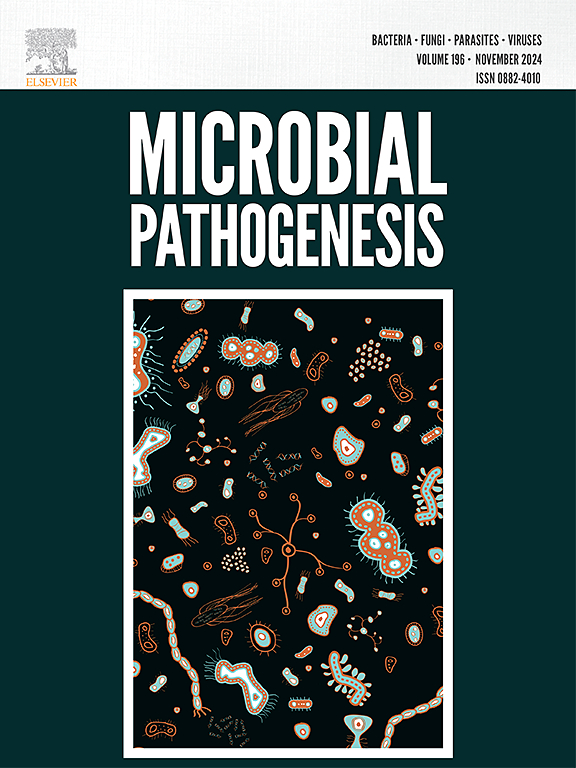CsrR modulates biofilm formation of ST-17 GBS through the regulation of a novel adhesion factor, BapB
IF 3.5
3区 医学
Q3 IMMUNOLOGY
引用次数: 0
Abstract
Introduction
The hypervirulent ST-17 clone of Group B Streptococcus (GBS) is a leading cause of neonatal invasive meningitis. The link between GBS biofilm formation and the ST-17 lineage is established, and the inhibition of GBS biofilm formation by CsrR involves the regulation of adhesins. However, the specific adhesins involved in biofilm formation in ST-17 GBS strains are unknown.
Hypothesis/gap statement
CsrR inhibits biofilm formation of ST-17 GBS through the regulation of specific adhesins.
Aims
To identify the adhesins contributing to biofilm formation in the ST-17 lineage.
Methodology
Comparative proteomics analyses of a strong biofilm-forming ST-17 strain and its csrR deletion mutant (ΔcsrR) were performed to identify the specific proteins involved in biofilm formation in ST-17 GBS. qPCR and biofilm formation assays were used to validate the proteomics analysis.
Results
A novel biofilm-associated protein, BapB, absent in non-biofilm-forming ST-17 GBS strains (e.g., COH1), was identified. Biofilm production was significantly attenuated in the bapB deletion mutant (ΔbapB), reducing GBS adherence to fibronectin and laminin.
Conclusion
BapB plays a crucial role in biofilm formation. It may be a potential target for design of new therapeutic approaches against GBS.
CsrR通过调节一种新的粘附因子BapB来调节ST-17 GBS的生物膜形成。
B群链球菌(GBS)的高毒力ST-17克隆是新生儿侵袭性脑膜炎的主要原因。建立了GBS生物膜形成与ST-17谱系之间的联系,并且CsrR对GBS生物膜形成的抑制涉及粘附素的调节。然而,参与ST-17 GBS菌株生物膜形成的特异性粘附素尚不清楚。假设/缺口陈述:CsrR通过调节特异性粘附素抑制ST-17 GBS生物膜的形成。目的:鉴定在ST-17谱系中促进生物膜形成的粘附素。方法:通过比较蛋白质组学分析ST-17强生物膜形成菌株及其csrR缺失突变体(ΔcsrR),确定ST-17 GBS中参与生物膜形成的特异性蛋白。采用qPCR和生物膜形成实验验证蛋白质组学分析。结果:鉴定出一种新的生物膜相关蛋白BapB,该蛋白在非生物膜形成的ST-17 GBS菌株(如COH1)中缺失。在bapB缺失突变体中,生物膜的产生明显减弱(ΔbapB),减少了GBS对纤维连接蛋白和层粘连蛋白的粘附。结论:BapB在生物膜形成中起重要作用。它可能是设计针对GBS的新治疗方法的潜在靶点。
本文章由计算机程序翻译,如有差异,请以英文原文为准。
求助全文
约1分钟内获得全文
求助全文
来源期刊

Microbial pathogenesis
医学-免疫学
CiteScore
7.40
自引率
2.60%
发文量
472
审稿时长
56 days
期刊介绍:
Microbial Pathogenesis publishes original contributions and reviews about the molecular and cellular mechanisms of infectious diseases. It covers microbiology, host-pathogen interaction and immunology related to infectious agents, including bacteria, fungi, viruses and protozoa. It also accepts papers in the field of clinical microbiology, with the exception of case reports.
Research Areas Include:
-Pathogenesis
-Virulence factors
-Host susceptibility or resistance
-Immune mechanisms
-Identification, cloning and sequencing of relevant genes
-Genetic studies
-Viruses, prokaryotic organisms and protozoa
-Microbiota
-Systems biology related to infectious diseases
-Targets for vaccine design (pre-clinical studies)
 求助内容:
求助内容: 应助结果提醒方式:
应助结果提醒方式:


